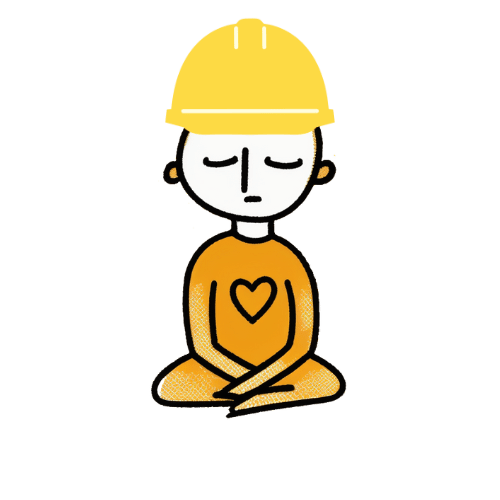Why meditate
There are countless reasons why people engage in meditation practices; however, one reason is shared by all: the wish to find happiness and be free from suffering.
Just as we intentionally engage in physical exercise to strive for a fit, healthy body, we also need to intentionally engage in positive mental exercise to cultivate a fit and healthy mind. This can be achieved through regular meditation practice. The essential meditation steps outlined in this article will help you to get started.
What are meditation and mindfulness practices?
Meditation is an ancient practice, whereby one repeatedly cultivates a beneficial state of mind, such as love, compassion, patience, concentration, and insight into oneself and the world which we inhabit.
MIndfulness meditation is one of many mindfulness practices, which involves developing non-judgmental awareness of present-moment experiences, including one’s thoughts, emotions, and sensations. Mindfullness practices can also include, walking meditations, mindful eating, and related breathing exercises and bodily sensations.
Benefits of meditation
The benefits of meditation and mindfulness practices can vary for different individuals.
Numerous studies have been conducted in the fields of psychology, neuroscience, medicine, and other related disciplines, providing evidence of the positive impact on an individual’s mental health and physical health by engaging in regular practice.
Benefits include; Reduced stress and anxiety, improved mental clarity and focus, emotional regulation skills and self-awareness. Reduced blood pressure, improved sleep quality, and the enhancement of the immune systems functionality.
Communication skills are easier to develop, empathy, and compassionate attitudes, experienced in daily life can be elevated leading to improved relationships with ourselves and others. To summarise an overall increased sense of well-being, positivity, and happiness can be attained.
How to start to meditate; Four key considerations
1: Validity of the source. 2: Types of meditation. 3: Meditation space.
4: Meditation posture.
Validity of source: Having made the decision to begin a meditation practice it’s highly recommended to verify the credibility and qualifications of the source which you will mainly rely upon, whether that is a meditation teacher at a centre, an online resource such as Peaceful Minds, a meditation app, or a book.
Types of meditation: There are many forms of meditation, starting with a simple practice such as a guided focus meditation or mindfulness of body and breath practice, which are ideal meditations for beginners, helping to establish a solid foundation to cultivate a daily meditation practice.
It is important to note that no form of meditation should be considered inherently superior to another. Rather, the most suitable type of meditation for an individual depends on their specific circumstances, needs, and goals at a given time.
There is a variety of meditation practices, ranging from spiritual Buddhist traditions, to transcendental meditation to numerous secular mindfulness techniques.
Five common types of meditation;
Mindfulness of our body and breath practice; Mindfulness of the body and breath practices help one become fully present and aware of bodily sensations, movements, and the breath without judgment or distraction. It is an ideal meditation for beginners, wishing to cultivate mindfulness, calm down the busy mind and find some peace.
Mindfulness of our thoughts and emotions; Mindfulness of our thoughts and emotions involves observing and acknowledging our thoughts and emotions free from judgment, attachment and aversion. Through engaging in this practice it is possible to attain greater emotional resilience and self-awareness.
Focus or Concentration meditation; Focus or concentration meditation involves training the mind to remain focused single pointedly on a chosen object of observation. There are countless objects we can select to focus the mind upon including physical sensations such as the breath, mental images, visualisations, such as a flower, or a ball of light, and energy points within our body, or our mind itself for instance.
Engaging in this type of practice enhances one’s ability to sustain attention, mindfulness, introspection, vigilance and mental clarity, improving our overall cognitive function
Analytical meditation; Analytical meditation is a form of meditation in which the meditator intentionally investigates the nature of phenomena, using their own intelligence, critical thinking, and logic. This form of meditation encourages the practitioner to examine their thoughts, emotions, and experiences, within the laboratory of their mind and to develop a clear and discerning awareness in regards to the nature of reality. Through this process, insights and realisations can arise, leading to greater clarity, wisdom, and self-awareness.
Loving-kindness meditation; Loving-kindness meditation is a practice that involves generating feelings of warmth, love, and compassion towards oneself and others. The practice entails developing a deeper appreciation of the shared pains we all experience as part of the human condition, recognising the similarities we have with others, we are then able to cultivate a deep empathy for others.
By reflecting on the kindness of others, we develop love, and by contemplating their suffering experiences, we develop compassion. This form of meditation has been shown to reduce stress, anxiety, feelings of loneliness, and depression while improving overall well-being and enhancing our social connections.
Meditation space; Creating a conducive meditation space, whether indoors or outdoors, can greatly impact the quality of one’s meditation practice and contribute to a more peaceful, focused and successful meditation.
A meditation space can be decorated with items that are personally meaningful, such as candles, flowers, or perhaps inspirational quotes, and pictures to create a sense of atmosphere and tranquillity.
In addition to the physical environment, it’s also important to consider the energy of the meditation space. Keeping the space clean, decluttered, and free from distracting objects can greatlyenhance the quality of your meditation practice.
It’s important to remember that the ideal meditation space may vary for different individuals. Some may prefer a quiet corner in their home, while others may find solace in meditating by the beach or in a park. Experimenting with different locations and finding what works best for you can help create a daily practice and enhance one’s experience of meditation.
Meditation posture; There are various detailed instructions available regarding how to set a conducive meditation posture, the benefits of which should not be underestimated. As a beginner, the key factor is to be able to sit comfortably, as physical discomfort will cause the mind to wander and detract from the quality of the meditation experience.
As a general guideline, when sitting, the back should be straight, the bottom slightly higher than the knees, the head slightly tilted forward, hands resting on the lap or thighs, and eyes can be either slightly open or closed, with the mouth shut. Taking the time to set a comfortable posture is a basic mindfulness meditation in itself which should form part of one’s meditation routine, when engaging in a formal practice, which includes sitting.
At the outset of one’s meditation journey a chair is perfectly suitable to support a good meditation posture, there is no requirement to purchase a meditation cushion or meditation bench, the key is comfort.
Meditation tips for beginners
Be gentle with yourself; Be gentle with yourself and let go of expectations for immediate results.
Consistent practice; Regular meditation practice, is key to developing one’s subconscious mind, even just a few minutes per day can be beneficial.
Time of day; There is no definitive best time of day. Experiment and find a time of day that best suits you and if possible create a daily routine based on that. Morning meditation can be conducive to setting the tone for the day, the key here is to avoid meditating whilst overly tired or when lacking enthusiasm, there will be little benefit gained if we have to drag ourselves to the meditation session.
Period of time; As a beginner, short, focused sessions are essential, in order to cultivate a mind that has the quality of stability and clarity. Eight to fifteen minutes of meditation time is recommended and also allows for generating an enthusiastic approach to meditation.
Goal of meditation; Setting a wholesome motivation and keeping this present in one’s mind can be very helpful. Whether an action is beneficial to ourselves or not is dependent upon our motivation.
Taking the time to reflect and set a wholesome motivation before engaging in the various meditation techniques will lead to a more meaningful and fulfilling experience, this applies to both meditation experts and beginner meditators.
If we engage in mindfulness and meditation practices with the motivation of not just benefiting ourselves but also others, our friends, family etc we can achieve a very broad and expansive mind, supported by compassion, and love and with this mind one will certainly feel the positive benefits throughout everyday life.


